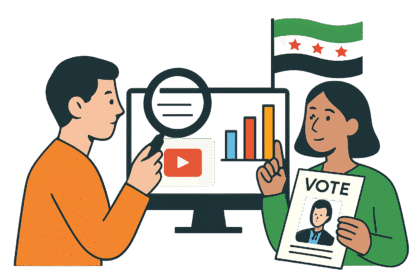
The Role of Media Monitoring in Evaluating Awareness Campaigns and Political Advertisements: An In-Depth Insight from Insight Syria
- Media monitoring is a crucial tool for evaluating the effectiveness of political campaigns.
- The methodologies involved include a mix of quantitative and qualitative approaches.
- Analyses measure the impact of campaigns on the audience and how they can be improved.
- Media monitoring faces significant challenges, but there are opportunities to enhance campaign strategies.
- AI and big data analytics are the future of media monitoring.
Table of Contents
- Main Content
- Methodologies Used in Media Monitoring to Evaluate Political Campaigns
- Insight Syria’s Expertise in Evaluating Awareness Campaigns and Political Advertisements
- Challenges and Opportunities in Political Media Monitoring
- Practical Applications of Media Monitoring
- The Future of Media Monitoring in the Syrian Context
- Conclusion
Main Content
In the complex and ever-changing media landscape, media monitoring stands out as an essential tool for evaluating the effectiveness and impact of awareness campaigns and political advertisements. Understanding how messages are received, their reach, and their impact on the targeted audience requires precise scientific methodologies and specialized field expertise. From this perspective, “Insight Syria,” as a pioneer in data research and analysis services in the Syrian context, provides an in-depth view of the role of media monitoring in evaluating awareness campaigns and political advertisements.
The importance of media monitoring goes beyond merely tracking what is being said; it involves analyzing the “how” and “why” behind the messages, and how the audience interacts with them. In the Syrian context, where media plays a pivotal role in shaping public opinion and influencing decisions, this monitoring becomes more crucial to ensure messages are effectively reaching their goals, whether the campaign aims to enhance civic engagement, raise awareness of a social issue, or even influence voter preferences, the evaluation of awareness campaigns and political advertisements relies heavily on the data and insights drawn from comprehensive and accurate monitoring.
Methodologies Used in Media Monitoring to Evaluate Political Campaigns
Monitoring methodologies aren’t limited to superficial tracking of media presence but require building analytical models capable of measuring multiple aspects of the campaign. At “Insight Syria,” we rely on a blend of quantitative and qualitative methods to provide a comprehensive evaluation.
First: Comprehensive Media Presence Monitoring
This aspect involves tracking all media appearances related to the campaign across various channels:
- Traditional channels: television, radio, newspapers, and magazines.
- Digital channels: news sites, blogs, social media platforms (Facebook, Twitter, YouTube, TikTok, Instagram, etc.).
- Paid vs. organic content: distinguishing between paid political advertisements and organically shared content.
Second: Content Analysis
Monitoring media appearances isn’t enough; analyzing the nature of the messages broadcasted is necessary:
- Textual Analysis: Studying the texts used in advertisements and awareness materials.
- Visual Analysis: Examining images, videos, graphs, and logos used.
- Auditory Analysis: The impact of music and sound effects in visual and auditory materials.
- Comparative Analysis: Comparing messages across different campaigns or between a campaign and competitors.
Third: Audience and Engagement Analysis
This aspect measures the reach and actual impact of the campaign on the audience:
- Reach Measurement: Estimating the number of people who viewed or heard the media message.
- Engagement Analysis: Measuring the interaction generated by the campaign.
- Sentiment Analysis: Understanding audience reactions to the campaign.
- Media Coverage Analysis: Evaluating the nature of media coverage of the campaign.
Fourth: Impact Measurement
This is the ultimate goal of any campaign, measured through several indicators:
- Awareness Impact: Has awareness increased about the issue, candidate, or party post-campaign?
- Attitude Impact: Have audience attitudes changed towards the issue, candidate, or party?
- Behavioral Impact: Has the campaign led to a change in audience behavior?
- ROI Analysis: Comparing the campaign cost with achieved results.
Insight Syria’s Expertise in Evaluating Awareness Campaigns and Political Advertisements
“Insight Syria” has profound expertise in methodologies and experience related to data collection and analysis in the complex Syrian context. We understand that the role of media monitoring in evaluating awareness campaigns and political advertisements requires an accurate understanding of the local landscape, including audience preferences, most effective communication channels, and influencing cultural and social factors.
- Specialized Team: Our team includes experts in data science, content analysis, sociology, and political sciences.
- Advanced Tools: We use the latest tools and software in media monitoring and data analysis.
- Customization as Needed: We design monitoring methodologies to fit the specific goals of each campaign.
- Focus on Syrian Context: Our deep expertise in the Syrian context allows us to interpret data considering local factors.
- Transparency and Reliability: We commit to the highest standards of transparency in data collection and analysis.
Challenges and Opportunities in Political Media Monitoring
Media monitoring in the context of political advertisements faces some challenges but simultaneously opens up new avenues for improvement:
- Challenges:
- Huge data volume and the quantity of content produced daily.
- Platform diversity and the difficulty of comprehensive monitoring.
- Media misinformation and fake news.
- Bias in coverage.
- Measuring indirect impact.
- Opportunities:
- Improving campaign strategies through accurate data.
- Increasing transparency and accountability in ad spending.
- A deeper understanding of the audience and accurate sentiment analysis.
- Combating media misinformation through collective efforts.
- Developing media policies based on acquired data.
Practical Applications of Media Monitoring
The role of media monitoring in evaluating awareness campaigns and political advertisements has widespread practical applications, including:
- Evaluating Health Awareness Campaigns: Such as vaccination campaigns.
- Analyzing Electoral Ads: To understand how messages appear and how voters react.
- Monitoring Human Rights Issues: To track media coverage of these issues.
- Evaluating Development Campaigns: Tracking project offerings and their reach to the public.
- Measuring the Impact of Political Discourse: On social and political stability.
The Future of Media Monitoring in the Syrian Context
With the continuous development of technology and the increasing reliance on digital platforms, monitoring methodologies are also evolving. At “Insight Syria,” we believe the future holds significant opportunities to leverage:
- AI and Machine Learning: To enhance the accuracy of sentiment analysis.
- Predictive Analytics: To forecast the success of future campaigns.
- Social Network Analysis: To study how information spreads.
- Big Data: To analyze larger amounts of data.
Conclusion
The role of media monitoring in evaluating awareness campaigns and political advertisements cannot be overstated. It is an essential process to ensure the effectiveness of campaigns, efficiently directing resources, and achieving desired goals. At “Insight Syria,” we are proud to offer advanced methodologies and expertise, supported by a deep understanding of the Syrian context. We are your partners in building impactful and successful campaigns, backed by data and scientific insights.
Frequently Asked Questions
What is the importance of media monitoring in political campaigns?
Media monitoring enhances the effectiveness of campaigns by evaluating message impact and audience reach.
How can the data derived from media monitoring be used?
The data helps improve campaign strategies, increase transparency, and gain a better understanding of audience trends.
What are the main challenges in media monitoring?
Challenges include data volume, platform diversity, and media misinformation.
What is the future for media monitoring methods?
With technological advancement, strategies will benefit from AI and big data to improve analysis and prediction.



